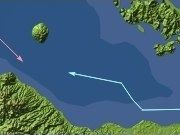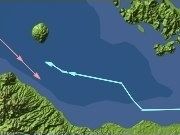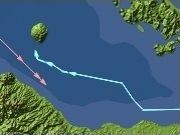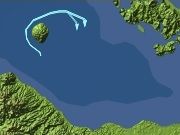




The track charts above show the attack of the van destroyers from Fletcher’s perspective. They have been prepared using the following data:
• 2308 radar contact, 285° T, 14,000 yards.
• 2310 change course.
• 2315 change course.
• 2316 request permission to fire torpedoes.
• 2320 receive permission to fire torpedoes.
• 2322 fire torpedoes.
• 2323 all ships open gunfire.
• 2325 cease fire.
• 2327 change course.
Click on any image to view it in more detail.
After shakedown, Fletcher passed through the Panama Canal and crossed the Pacific. En route, Cole and his XO, Lt. Joseph (“Bill”) Wylie got to know their new tool and evolved a method for using it to best advantage.
At general quarters, rather taking the traditional station at the secondary conn aft, Wylie moved to the charthouse through an open door abaft the navigation bridge. There, within conversational distance of his skipper and in communication with the gunnery officer, he could watch the PPI scope. The method proved effective, and Fletcher used it to advantage during the Battle of Guadalcanal, 13 November.Improvements were possible. One was to move the Dead Reckoning Tracer (DRT) from its vertical bulkhead mounting to a horizontal one that could be used with the PPI scope to plot others ships’ courses and speeds. Cole, Wylie and crew thus approached Tassafaronga as an experienced radar team with the latest tool, leading the formation.
Within a minute, Wright ordered all ships to open gunfire. He later claimed that the van destroyers had opened gunfire first. It may be that he had seen a flash from torpedo salvo.
Soon, explosions were seen astern as Takanami’s torpedo spread hit Minneapolis and Northampton. At 35 knots, the four destroyers rushed around the north side of Savo Island—spotting the explosion of Northampton over the island. Speeding back to rejoin the fray in two sections—Fletcher and Perkins to the east, Maury and Drayton 3000 yds. to the west—they received an order from RAdm, Tisdale to find and stand by the damaged cruisers.
Unable to differentiate American from Japanese, the two formations closed several burning ships. Cole ordered Maury and Perkins to stand by New Orleans and then Pensacola while Fletcher and Drayton joined Honolulu in a sweep back toward the battle area; then, while Honolulu continued on to the west, the two stopped to aid Northampton just before she sank. Fletcher picked up 646 survivors and Drayton 127 before retiring to Espiritu Santo.